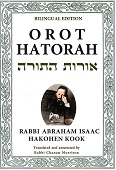
During the first day of mourning, there is one mitzvah that a person should not observe: the mitzvah of tefillin.
Why are mourners exempt from wearing tefillin?
Tefillin and Mourning
The Sages explained that tefillin have a unique quality of majesty. Thus we find that they are called pe'er (פאר), meaning splendor or beauty. When Ezekiel was instructed not to observe the customary practices of mourning after his wife’s death, he was told: “bind your splendor (pe'ercha) upon yourself” (Ezek. 24:17). Despite his personal loss, the prophet was commanded to continue to wear his beautiful tefillin.
Similarly, our custom on Tisha B'Av is not to wear tefillin during the morning hours, when our grief over the destruction of the Temple is the most intense (see also Mishneh Torah, Laws of Fasts 5:11).
Why is wearing tefillin inappropriate during times of mourning?
“They will be in awe of you”
The key, Rav Kook explained, lies in this description of tefillin as pe'er. Beauty serves to make an impression on others. When we perform a mitzvah in a beautiful way (hiddur mitzvah), we intend to engage our emotions and sense of aesthetics. When we speak of the spiritual beauty of tefillin, this indicates that they have the potential to inspire and make an impact on others.
This quality of tefillin is supported by Rabbi Eliezer’s explanation of the verse:
וְרָאוּ כׇּל־עַמֵּי הָאָרֶץ כִּי שֵׁם ה’ נִקְרָא עָלֶיךָ וְיָרְאוּ מִמֶּךָּ׃
“All the nations of the world will see that God’s Name is called upon you and they will be in awe of you.” (Deut. 28:10)
In what way will the nations of the world see that “God’s Name is called upon you”? Rabbi Eliezer in Berachot 6a explained this in a literal fashion. He taught that the verse refers to the tefillin worn on the head. Tefillin, containing passages from the Torah mentioning God’s Name, are a visible sign for others that “God’s Name is called upon you.”
Rabbi Eliezer saw tefillin as a vehicle for influencing and inspiring others: “and they will be in awe of you.”
A Time to Draw Inwards
How does this explain the Halachah that a mourner should not wear tefillin?
To influence others, the soul must be in a state of strength and joy. By drawing upon our inner joy, we are able to demonstrate a path of enlightenment for others.
Bereavement and sorrow, of course, have their place; there are times when we need to mourn. But when the heart is heavy with pain and grief, we cannot reach out to others. It is wrong to influence others while feeling bereaved and embittered. No good will come from spreading sorrow to others.
For this reason, when we are overcome with grief, it is not a suitable time to adorn ourselves with tefillin and their spiritual splendor. It is a time to draw inwards, not radiate outwards. We should wait until God dispels the darkness and we are able to return to Him with the complete teshuvah of love. Then we will may reach out to others and illuminate them with a path of light and joy.
(The Splendor of Tefillin. Adapted from Ein Eyah vol. I, 1:157 on Berachot 11a)





